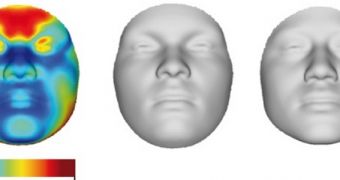A team of investigators led by Mark Shriver, an anthropologist at the Pennsylvania State University (Penn State), announces the development of a new method for reconstructing a 3D model of a person's face, based on the analysis of their DNA material. This innovation could one day allow forensic experts to identify the face of a perpetrator based solely on a strand of hair left behind at the crime scene.
At this point, the new technique is in its earliest stages and can only produce crude 3D representations of a human face. However, scientists say that its performances will definitely be improved over the next few years. Genes have been used to identify eye and hair color in the past, but never for recreating an entire face from scratch, Nature News reports.
In the new study, scientists collected high-resolution photographs of 592 test participants in Brazil, Cape Verde, and the United States. Subjects were of either European or West African ancestry, says Shriver. Details of the research effort and the methodology the team used appear in the March 20 issue of the open-access, peer-reviewed journal PLoS Genetics.
Each of the images was then spread over a digital frame, which featured over 7,000 data points. The team analyzed how much each face varied from the average, looking for particularities such as flatter noses or wider cheekbones. A group of volunteers then took turns voting which of the faces belonged to men, and which to women. Ethnicity was also established in the same manner.
Afterwards, the team searched for single nucleotide polymorphism (SNP) in DNA samples collected from all test subjects. These SNP are basically locations in the genome where DNA varies between individuals by just one of four bases. Genes that other studies identified as potentially having a role to play in facial development were particularly targeted.
The next step was to calculate the statistical probability that any given SNP plays a role in determining the nature and evolution of a single facial feature. This calculation also took into account the gender and ancestry of each test participant. A total of 20 genes revealed 24 SNP that exhibited a very strong association with facial shape, the team reports.
These results were then fed into a newly-developed computer software, which takes SNP variations into account to construct a predictive 3D facial model of the person the DNA sample was collected from. The Penn State team now plans to include more genetic material and more people into the research, so the resolution of the reconstructed faces can be improved.
The group also determined that it is infinitely more complex to reconstruct an entire face than it is to predict skin color based on genome samples. “One thing we’re certain of: there's no single gene that suddenly makes your nose big or small,” explains Shanghai Institutes for Biological Sciences expert Kun Tang.

 14 DAY TRIAL //
14 DAY TRIAL //